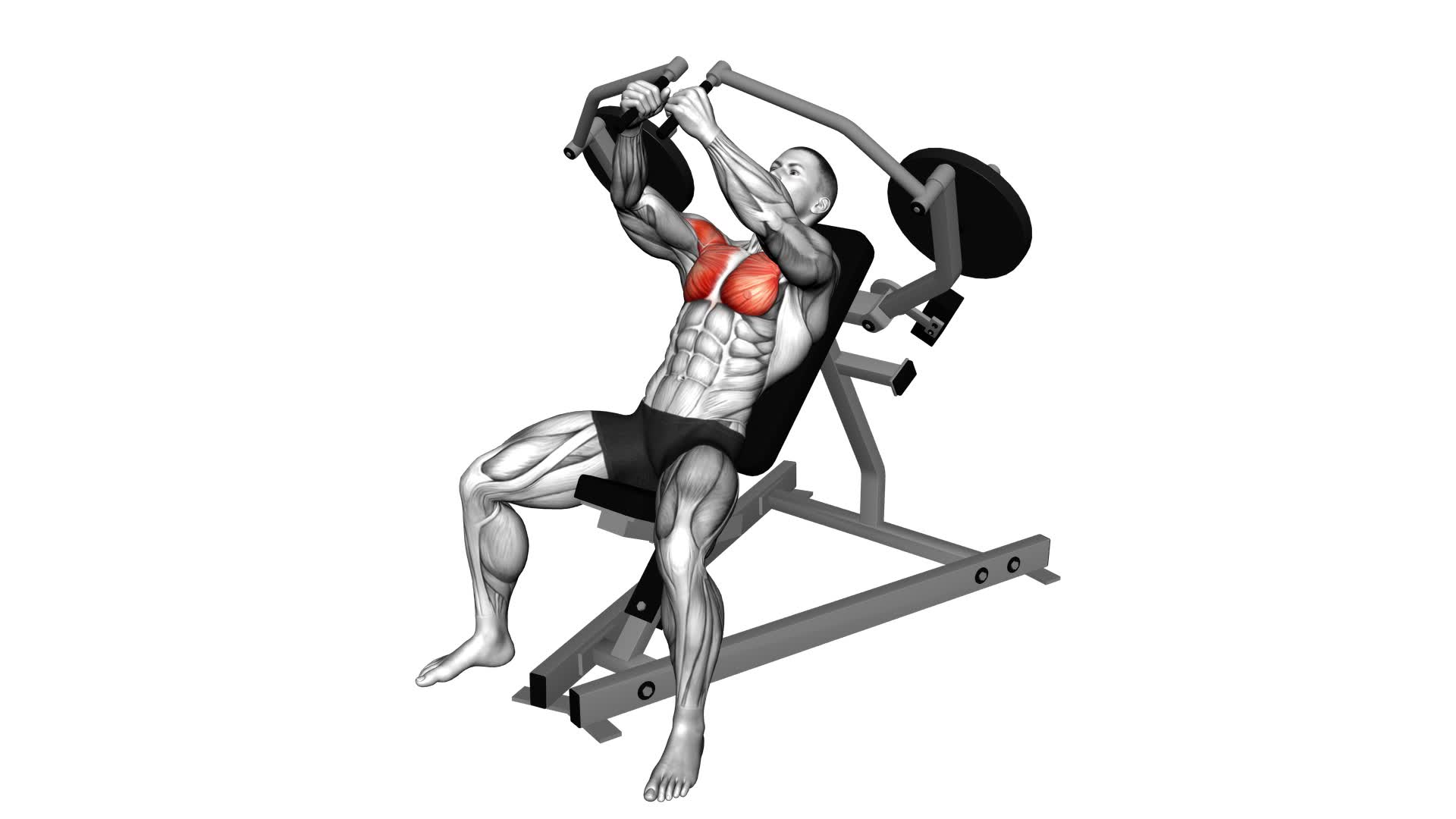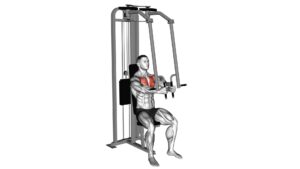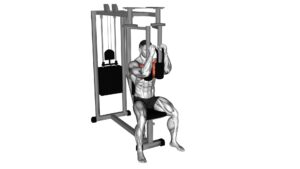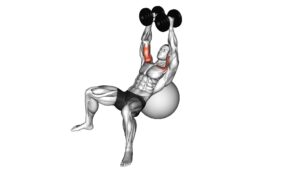Lever Incline Fly (male) – Video Exercise Guide & Tips

Are you looking to add a challenging and effective exercise to your workout routine? Look no further than the Lever Incline Fly.
Watch This Exercise Video
This exercise targets your chest muscles and helps improve upper body strength. In this article, we'll guide you through the proper form and technique, provide variations and modifications, and share common mistakes to avoid.
Get ready to take your chest workouts to the next level with the Lever Incline Fly.
Let's dive in!
Key Takeaways
- Lever incline fly targets the pectoralis major and minor muscles in the chest and engages the anterior deltoids in the shoulders.
- Proper form and technique, such as keeping arms slightly bent and focusing on squeezing chest muscles, is important for maximizing the effectiveness of the exercise.
- Variations and modifications, like trying the decline lever incline fly or using resistance bands, can be used to target different muscle groups and add variety to the workout.
- Stability and proper form are crucial for injury prevention and engaging the targeted muscles more effectively during workouts.
Benefits of the Lever Incline Fly
You'll experience increased chest strength and shoulder stability with the Lever Incline Fly. This exercise targets the muscles in your chest, specifically the pectoralis major and minor, as well as the muscles in your shoulders, such as the anterior deltoids. By incorporating the Lever Incline Fly into your workout routine, you can reap numerous benefits.
One of the main benefits of the Lever Incline Fly is improved muscle activation. As you perform this exercise, your chest muscles are activated to lift the weight against resistance. This leads to increased muscle fiber recruitment and ultimately results in greater strength gains. Additionally, the Lever Incline Fly also engages your shoulder muscles, promoting stability and balance in this area.
Another advantage of the Lever Incline Fly is its ability to target the upper chest. By adjusting the incline of the bench, you can emphasize the upper portion of your chest, helping to develop a well-rounded and defined chest. This exercise also promotes better posture by strengthening the muscles that support your shoulder girdle.
Incorporating the Lever Incline Fly into your training routine can provide you with a wide range of benefits, including increased chest strength and shoulder stability, improved muscle activation, and enhanced upper chest development. So why wait? Start including the Lever Incline Fly in your workouts and experience these benefits for yourself.
Proper Form and Technique
To ensure proper form and technique for the Lever Incline Fly, how can you effectively engage your chest and shoulder muscles?
The Lever Incline Fly is an effective exercise for targeting the chest and shoulder muscles. Proper form and technique are crucial to maximize the benefits and prevent injury. Before starting the exercise, it's important to warm up and stretch the muscles to increase flexibility and reduce the risk of injury. Stretching helps to improve the range of motion and allows for better muscle activation during the exercise.
To engage your chest and shoulder muscles effectively during the Lever Incline Fly, begin by positioning yourself on the incline bench with your feet firmly planted on the ground. Grasp the handles of the lever machine with an overhand grip and keep your arms slightly bent. As you lower the handles towards your sides, focus on squeezing your chest muscles and keeping your shoulder blades pulled back and down. This will ensure proper muscle activation and engagement throughout the movement.
By following these tips for proper form and technique, you can effectively target your chest and shoulder muscles during the Lever Incline Fly.
Now, let's explore some variations and modifications of this exercise to further challenge your muscles and add variety to your workout routine.
Variations and Modifications
To add variety and challenge to your Lever Incline Fly workout, try incorporating different variations and modifications. By changing up your routine, you can target different muscle groups and continue to make progress in your fitness journey.
One variation you can try is the Decline Lever Incline Fly. This involves setting the bench at a decline angle instead of an incline angle. This variation puts more emphasis on the lower chest muscles and can help to further develop your overall chest strength.
Another modification you can make is to use resistance bands instead of dumbbells. This allows for a different type of resistance and can add an element of instability to the exercise, engaging additional muscles for stabilization.
Additionally, you can vary the tempo of the exercise by performing slow and controlled repetitions or incorporating explosive movements. This change in tempo can challenge your muscles in new ways and enhance your overall strength and power.
Remember to always listen to your body and choose variations and modifications that align with your fitness level and goals.
Common Mistakes to Avoid
To prevent injury and ensure optimal results, it's important to be aware of common mistakes to avoid when performing the Lever Incline Fly exercise. By understanding these mistakes and focusing on proper execution, you can maximize the benefits of this exercise while minimizing the risk of injury.
One common mistake to avoid is using too much weight. It's important to start with a weight that you can comfortably handle and gradually increase it as you become stronger. Using too much weight can lead to improper form and strain on the muscles and joints.
Another mistake to avoid is using momentum to complete the exercise. The Lever Incline Fly should be performed in a controlled manner, with a slow and deliberate movement. Using momentum not only reduces the effectiveness of the exercise, but it also increases the risk of injury.
Proper form is crucial when performing the Lever Incline Fly. Avoid arching your back or rounding your shoulders, as this can lead to strain on the lower back and shoulders. Keep your back flat against the bench and your shoulders pulled back and down throughout the exercise.
Lastly, avoid locking out your elbows at the top of the movement. Instead, maintain a slight bend in your elbows to keep tension on the muscles and prevent excessive stress on the joints.
Tips for Incorporating the Lever Incline Fly Into Your Workout Routine
To effectively incorporate the Lever Incline Fly into your workout routine, consistency is key. This exercise is a great addition to your upper body strength training, specifically targeting your chest muscles. Here are some tips to help you make the most out of this exercise.
Firstly, it's important to start with a weight that challenges you but still allows you to maintain proper form. Using too heavy of a weight can lead to injuries and ineffective results. Gradually increase the weight as you get stronger.
Secondly, focus on your form throughout the exercise. Keep your core engaged and your back flat against the bench. Your elbows should be slightly bent and your arms should move in a controlled and fluid motion.
As with any exercise, breathing is important. Inhale as you lower the weight and exhale as you bring it back up. This will help you maintain stability and maximize your effort.
Lastly, don't forget to warm up before starting your workout. This can be as simple as a few minutes of light cardio or dynamic stretches to increase blood flow to your muscles.
Frequently Asked Questions
How Many Sets and Reps Should I Do for the Lever Incline Fly Exercise?
When it comes to the lever incline fly exercise, it's important to consider how many sets and reps you should do. The number of sets and reps can vary depending on your fitness level and goals.
It's generally recommended to start with 3-4 sets of 8-12 reps. This will help target and strengthen your chest muscles effectively.
However, it's always best to consult with a fitness professional to determine the optimal set and rep range for your specific needs.
Can Women Also Perform the Lever Incline Fly Exercise?
Yes, women can also perform the lever incline fly exercise. It offers several benefits for them, such as targeting the chest, shoulders, and triceps. It helps in strengthening these muscles and improving upper body strength.
Women can modify the exercise by using lighter weights or resistance bands to suit their individual fitness levels. It's important to maintain proper form and technique to avoid any strain or injury.
Consulting with a fitness professional can provide additional guidance and personalized modifications.
Is the Lever Incline Fly Exercise Suitable for Beginners?
The lever incline fly exercise can be suitable for beginners when performed with proper form and technique. To start, make sure to set the lever at a comfortable height and select an appropriate weight.
Focus on maintaining a stable position and keeping your core engaged throughout the movement. For beginners, it may be helpful to start with lighter weights and gradually increase as you gain strength and confidence.
Remember to listen to your body and make modifications as needed to avoid injury.
What Muscles Does the Lever Incline Fly Primarily Target?
The lever incline fly primarily targets your chest muscles, specifically the pectoralis major and minor. Incorporating this exercise into your upper body workout has several benefits.
It helps to build strength and definition in your chest, improves your posture, and enhances upper body stability.
To perform the lever incline fly properly, lie on an incline bench with a dumbbell in each hand. Keep your elbows slightly bent and lower the weights out to the sides, then bring them back up using controlled movements.
Can I Use Dumbbells Instead of a Lever Machine for the Incline Fly Exercise?
Yes, you can definitely use dumbbells instead of a lever machine for the incline fly exercise. While the lever machine provides a stable and controlled movement, dumbbells offer more freedom and range of motion.
This can engage additional stabilizer muscles and challenge your coordination. However, the lever machine has the advantage of isolating the target muscles more effectively, ensuring a proper form and reducing the risk of injury.
Conclusion
Incorporating the lever incline fly into your workout routine can provide numerous benefits, such as targeting the chest muscles and improving upper body strength. By following proper form and technique, avoiding common mistakes, and considering variations and modifications, you can maximize the effectiveness of this exercise.
Remember to consult with a fitness professional before attempting any new exercises and always listen to your body to prevent injury. With consistency and dedication, you can achieve your fitness goals with the lever incline fly.

Author
Years ago, the spark of my life’s passion ignited in my mind the moment I stepped into the local gym for the first time. The inaugural bead of perspiration, the initial endeavor, the very first surge of endorphins, and a sense of pride that washed over me post-workout marked the beginning of my deep-seated interest in strength sports, fitness, and sports nutrition. This very curiosity blossomed rapidly into a profound fascination, propelling me to earn a Master’s degree in Physical Education from the Academy of Physical Education in Krakow, followed by a Sports Manager diploma from the Jagiellonian University. My journey of growth led me to gain more specialized qualifications, such as being a certified personal trainer with a focus on sports dietetics, a lifeguard, and an instructor for wellness and corrective gymnastics. Theoretical knowledge paired seamlessly with practical experience, reinforcing my belief that the transformation of individuals under my guidance was also a reflection of my personal growth. This belief holds true even today. Each day, I strive to push the boundaries and explore new realms. These realms gently elevate me to greater heights. The unique combination of passion for my field and the continuous quest for growth fuels my drive to break new ground.



